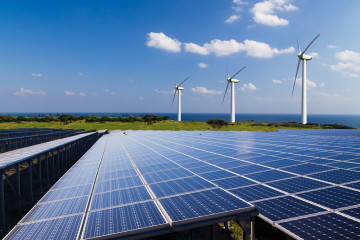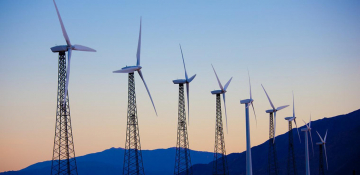
2025 is shaping up to be a historic year of transitions within the energy sector. The world’s appetite for energy continues to grow significantly. The industry is rising to meet this demand, but in starkly different ways across regions. While international investment in renewables surges forward, some major energy players are shifting focus back to fossil fuels.
Meanwhile, political shifts are influencing the energy landscape. The election of Donald Trump in the U.S. is bringing a resurgence of oil and gas development, with regulatory rollbacks aimed at expanding domestic production. However, despite Trump’s skepticism of renewables, some experts believe that private sector investment in clean energy will continue at pace, particularly as bipartisan support for renewable incentives remains strong.
With so much in flux, here’s a look at the key developments shaping the energy transition and what to expect in the year ahead.
The State of Energy Transition: 2025
These are the major trends that will shape a momentous year for the energy sector in 2025, and how we think they might affect you.
Global energy demands continue to rise strongly, reaching two-decade high
According to the International Energy Agency’s Electricity Mid-Year Update, global electricity consumption will grow by 4%, matching its strong growth in 2024, which was the highest annual growth rate since 2007. This would bring global energy demand to the highest levels in the past two decades.
The majority of this demand will come from developing economies, mainly in Asia but also in Latin America, the Middle East, and Africa, where the decoupling of economic development and energy consumption has yet to take place.
Meanwhile, most developed countries will show little, if any, growth in energy consumption. In fact, the EIC expects Europe’s demand for energy to be completely static in 2025 before it begins to decline in 2026, as a result of slow economic growth and aggressive energy-saving measures.
The U.S. could be the exception to this rule in developed countries. With Donald Trump taking office and his moves to remove existing emission standards and environmental regulations, the EIC projects this will lead to increased energy consumption in the US.
Source: EIU
Renewable energy investment is on the rise, but not for all
Much of the new electric energy supplied worldwide is expected to come from renewable energy sources. The IEA projects that the sector will expand its share of global electricity supply from 30% in 2023 to 35% in 2025.
The largest growth will be in the solar energy sector. The IEA projects that Solar PV alone will meet around half of the increased demand for global electricity in 2025. Wind energy will also proliferate, and wind and solar together are expected to meet as much as 75% of the new demand.
In their Energy Outlook 2025 Report, the Economic Intelligence Unit forecasts that more than 250 GW of combined solar and wind capacity will be installed in 2025. Most of this new capacity will be installed in China, which continues to be a major source and the main destination of investment into renewables.
However, while global renewable energy expansion continues, not all major energy companies are maintaining aggressive clean energy targets. BP recently announced a strategic shift, scrapping its goal to increase renewable generation 20-fold by 2030 and refocusing on fossil fuels to address investor concerns over earnings. This follows BP’s earlier move to scale back its target for reducing oil and gas output by the end of the decade. The decision highlights the ongoing tension between accelerating the energy transition and balancing financial performance in the sector.
Source: EIU
If renewable energy solutions can keep this pace, early 2025 will mark the first year when renewables generate more electricity than coal worldwide.
American policy reprioritizes oil and gas production, deprioritizes renewable energy
From day one after Donald Trump took office, he began following through on his promises to weaken environmental regulations in the energy sector, reduce U.S. government subsidies for renewable energy, and remove barriers to oil and gas production. He also declared a national energy emergency to speed up fossil fuel development. Trump’s goals for these policies are to incentivize U.S. oil and gas drilling in order to make the U.S. “energy dominant” around the world.
Even before taking office, these proposed policies already had a large impact on energy sector stock activity. The Energy Select Sector SPDR Fund (XLE), which represents energy stocks in the S&P 500, climbed by nearly 4% the day after the election was called for Trump. Meanwhile, renewable energy companies in the U.S. faced significant declines; for example, U.S. solar company First Solar experienced a stock drop of over 10 percent.
Deloitte also projects that the U.S. Fed will reduce interest rates by nearly 100 basis points in 2025. This should help both established and emerging oil and gas companies expand their operations. They also project the deal value of mergers and acquisitions in the gas and oil industries to continue to rise under Trump, increasing the profitability of consolidation and increasing shareholder returns.
Source: Deloitte
Despite the Trump administration’s prioritization of fossil fuel production, however, private industry interest in renewable energy and the Trump administration’s tariffs on foreign trade may stall some of the significant uptick in oil and gas production expected.
- Learn more on our blog: Here’s What Oil and Gas Companies Should Know About the Transition Risk Landscape
President Trump paused funding to the Inflation Reduction Act
One of Trump’s major campaign promises was to overturn the Biden administration’s Inflation Reduction Act (IRA), but whether he will be able to do so or not remains to be seen.
On his first day in office, he signed his “Unleashing American Energy” executive order which froze the distribution of IRA funds. While a judge ordered the Trump administration to restore these paused payments, the funds haven’t been released yet.
The IRA is the largest clean energy investment in U.S. history, containing over $300 billion in spending to spur investments in clean energy. It also opened access to several clean energy tax incentives to tax-exempt entities like state and local governments for the first time.
Despite the fact that no Republicans voted for the IRA at the time it was passed, the majority of the states that have benefited from the tax breaks it introduced in the past two years have been Republican. According to data from the research firm Atlas Public Policy, roughly 80% of the new clean energy manufacturing investments announced since the IRA passed are headquartered in Republican congressional districts.
Source: New York Times
These economic benefits have helped the IRA build considerable bipartisan support. In August 2024, 18 house Republicans signed a letter asking Speaker Mike Johnson to spare the energy tax credits from efforts to repeal the IRA.
In the letter, these Republicans argued that “Prematurely repealing energy tax credits, particularly those which were used to justify investments that already broke ground, would undermine private investments and stop development that is already ongoing.”
Sentiment like this from Republicans has prompted some analysts to predict that Trump will face significant bipartisan opposition to a full repeal of the IRA. Instead, most policy experts believe the new Republican-majority congress will likely impose new federal clean energy subsidy limits but will not vote to terminate most 2022 climate law tax credits.
“I think it will be a matter of selective repeal and amendment,” Department of Treasure assistant secretary for tax policy David Kautter recently summarized.
The Bottom Line for Energy Transition in 2025
Ultimately, 2025 will likely see considerable growth across all facets of the energy sector, as public and private concerns ramp up to capitalize on new opportunities and satisfy growing demands. How the energy industry adapts and grows starting in 2025 will have even greater consequences for the state of the world’s economy and politics than ever before.
To keep up with the latest developments on this pivotal year for the energy sector and the world at large, sign up for our monthly newsletter below.
Want more news and insights like this?
Sign up for our monthly e-newsletter, The New Leaf. Our goal is to keep you updated, educated, and even a bit entertained as it relates to all things EHS and sustainability.
Have any questions?
Contact us to discuss your environment, health, safety, and sustainability needs today.






